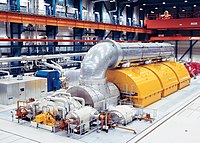
Photo from wikipedia
Abstract Inter-area generation expansion planning in a multi-period timescale with minimization of expansion cost and pollution is proposed in this paper. The expansion decision is made in a deregulated environment… Click to show full abstract
Abstract Inter-area generation expansion planning in a multi-period timescale with minimization of expansion cost and pollution is proposed in this paper. The expansion decision is made in a deregulated environment from the viewpoint of the strategic competitor. In this regard, the GENCO can expand its generation units accessing various generation technologies as candidate expansion plans in the main area. The main area consists of several buses while the adjacent areas are modeled as a single bus. The behavior of the other competitors is considered predictable by the strategic GENCO. In this study, the uncertainties of load, electricity price and wind speed are included. To confront them, rough neural network methodology is employed to forecast the uncertain parameters. In order to achieve cleaner environment and sustainable development policies, pollution constraint and taxes are employed in addition to the main costs where different carbon emission penalties are applied to each generation technology production. Different scenarios are proposed in order to investigate the effect of both multi-market and pollution barriers considerations on generation companies’ decision-making and profitability. In the field of multi-markets, the scenarios are designed so as to evaluate the extra income opportunities triggered by selecting optimal locations which have appropriate electrical accessibility to adjacent markets. In the scope of pollution barriers, the purpose of the suggested scenarios is to observe the companies’ investment combinations and future revenues by applying regulatory constraints like carbon taxes and quotas. Indeed, the findings underline that by engaging pollution control policies, the total emissions can be dramatically reduced up to 45% while maintaining an acceptable income for the generation companies taking advantage of participating in adjacent electricity markets.
Journal Title: Journal of Cleaner Production
Year Published: 2020
Link to full text (if available)
Share on Social Media: Sign Up to like & get
recommendations!